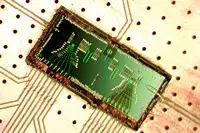 What is said to be a major step forward in the development of quantum computing systems has been made by researchers at Princeton University in the US. The team has built a laser the size of a grain of rice powered laser powered by single electrons tunnelling through quantum dots. The microwave laser (maser) is said to demonstrate the fundamental interactions between light and moving electrons.
What is said to be a major step forward in the development of quantum computing systems has been made by researchers at Princeton University in the US. The team has built a laser the size of a grain of rice powered laser powered by single electrons tunnelling through quantum dots. The microwave laser (maser) is said to demonstrate the fundamental interactions between light and moving electrons.
The original aim of the project was not to build a maser, but to explore how to use double quantum dots as quantum bits. Because quantum dots can communicate through the entanglement of light particles, or photons, the researchers designed dots that emit photons when single electrons leap from a higher energy level to a lower energy level to cross the double dot.
Each double quantum dot can only transfer one electron at a time, said Jason Petta, an associate professor of physics. "It is like a line of people crossing a wide stream by leaping onto a rock so small that it can only hold one person," he said. "They are forced to cross the stream one at a time. These double quantum dots are zero-dimensional as far as the electrons are concerned – they are trapped in all three spatial dimensions."
The researchers fabricated the double quantum dots from 50nm diameter indium arsenide nanowires. These were patterned over smaller metal wires that act as gate electrodes.
When the device was switched on, electrons flowed single-file through each double quantum dot, causing them to emit photons in the microwave region of the spectrum. These photons then bounced off mirrors at each end of the cavity to build into a coherent beam of microwave light.
The device demonstrates a major step forward for efforts to build quantum computing systems out of semiconductor materials, according to Jacob Taylor, an adjunct assistant professor at the Joint Quantum Institute, University of Maryland-National Institute of Standards and Technology. "I consider this to be a really important result for our long term goal, which is entanglement between quantum bits in semiconductor-based devices."
One advantage of the new maser is that the energy levels inside the dots can be fine-tuned to produce light at other frequencies, something not possible with other semiconductor lasers.
Author
Graham Pitcher
Source: www.newelectronics.co.uk

